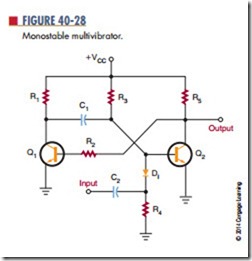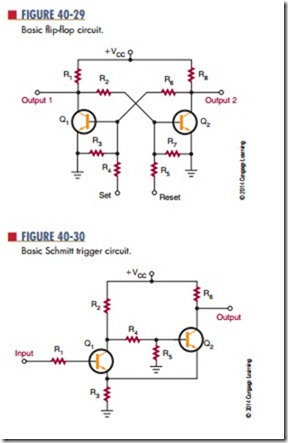special–purpose Circuits
The prefix mono– means “one.” A monostable multivibrator has only one stable state. It is also called a one-shot multivibrator because it produces one output pulse for each input pulse. The output pulse is generally longer than the input pulse. Therefore, this circuit is also called a pulse stretcher. Typically, the circuit is used as a gate in computers, electronic control circuits, and communication equipment.
Figure 40-28 shows a schematic diagram of a monostable multivibrator. The circuit is normally in its stable state. When it receives an input trigger pulse,
it switches to its unstable state. The length of time the circuit is in the unstable state is determined by the RC time constant of resistor R3 and capacitor C1. Capacitor C2 and resistor R4 form a differentiator circuit, which is used to convert the input pulse to a positive spike and a negative spike. Diode D1 allows only the negative spike to pass through to turn on the circuit.
A bistable multivibrator is a multivibrator hav- ing two stable states (bi-, meaning “two”). This circuit requires two inputs to complete one cycle. A pulse at one input sets the circuit to one of its stable states. A pulse at the other input resets it to its other stable state.
This circuit is often called a flip-flop because of its mode of operation (Figure 40-29).
A basic flip-flop circuit produces a square or rectangular waveform for use in gating or timing signals or for on–off switching operations in binary counter circuits. A binary counter circuit is essentially two transistor amplifiers, with the output of each transistor coupled to the input of the other transistor. When an input signal is applied to the set input, transistor Q1
turns on, which turns transistor Q2 off. When transistor Q2 turns off, it places a positive potential on the base of transistor Q1, holding it on. If a pulse is applied to the reset input, it causes transistor Q2 to conduct, turning off transistor Q1. Turning off transistor Q1 holds transistor Q2 on.
Discrete versions of the flip-flop find little application today. However, integrated circuit versions of the flip-flop find wide application. It is perhaps the most important circuit in digital electronics, used for frequency division, data storage, counting, and data manipulation.
Another bistable circuit is the schmitt trigger (Figure 40-30). One application of the Schmitt trigger is to convert a sine wave, sawtooth, or other irregularly shaped waveform to a square or rectangular wave. The circuit differs from a conventional bistable multivibrator in that a common-emitter resistor (R3) replaces one of the coupling networks. This provides additional regeneration for quicker action and straighter leading and trailing edges on the output waveform.
Questions
1. What is a monostable multivibrator?
2. Draw a schematic diagram of a one-shot multivibrator.
3. What is a bistable multivibrator?
4. Draw a schematic diagram of a flip-flop.
5. How does a Schmitt trigger differ from a con- ventional bistable multivibrator?

